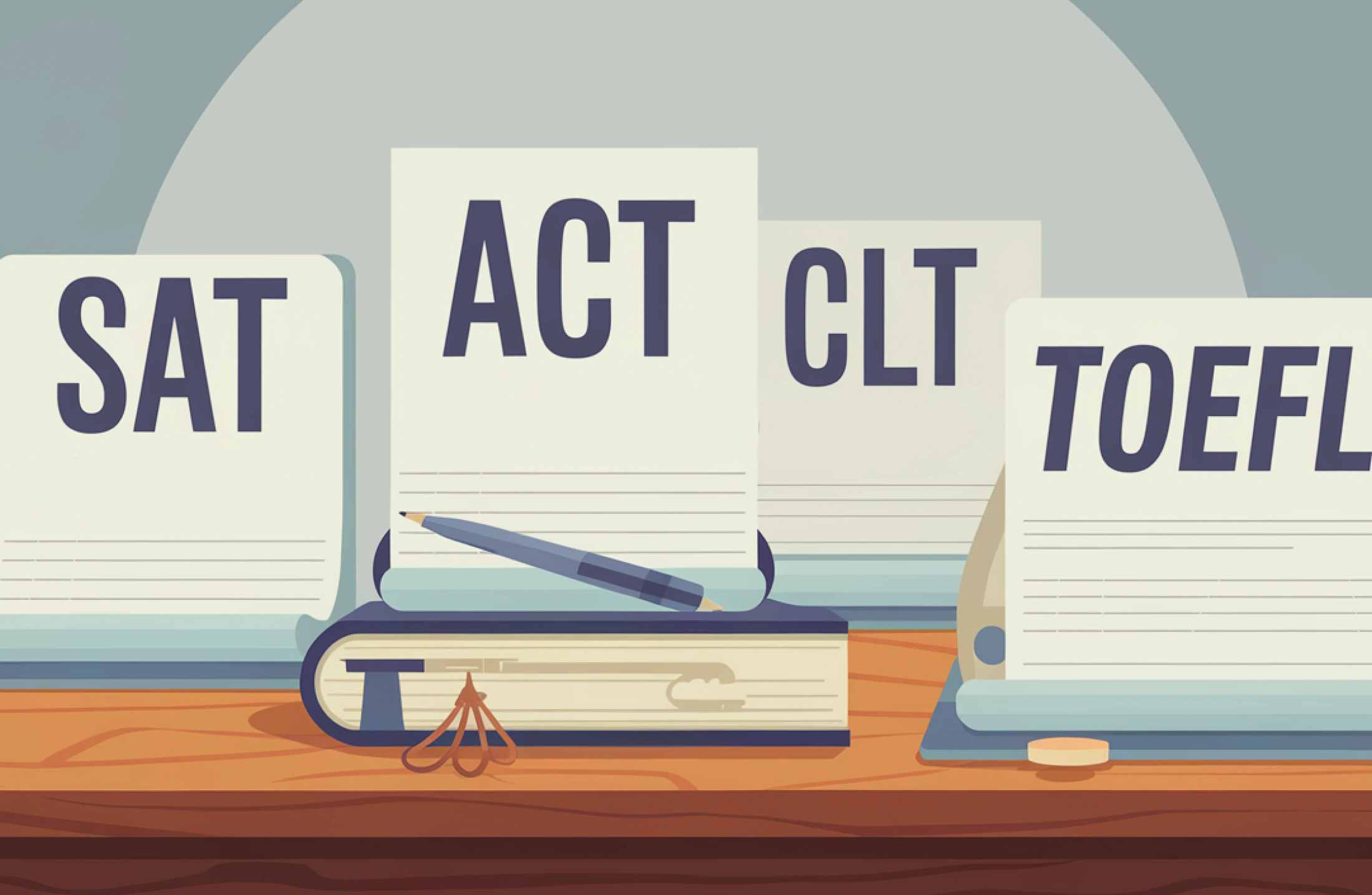Which College Admissions Tests Are Most Important for Getting Accepted?

Getting excited yet? College is just on the horizon, and all of your years of hard work are finally about to pay off. As you gear up for the next phase of your educational journey, it's time to start thinking about which admissions tests you will take. The test you must take will vary depending on where you hope to attend college.
But what if you don't know where you want to attend school? How are you to know which subject tests to take? That's where we at Varsity Tutors come in. Whether you already have a plan for where you want to attend school or are simply trying to increase your chances of acceptance into college, we can point you in the right direction.
Join us as we explore the different admissions tests you can take, including the American College Test (ACT), Scholastic Aptitude Test (SAT), and Classic Learning Test (CLT). From their structure and subject material to which schools typically require them, we’ll cover everything you need to know to make an informed decision.
The Importance of Standardized Testing in the College Admissions Process

Standardized testing has long been a cornerstone of college admissions. But why do colleges require these examinations? The answer lies in their ability to provide a level playing field for students nationwide. Think about it: GPAs and course rigor vary significantly between schools. These numbers don't tell the entire story. However, standardized tests like the ACT, SAT, and CLT give the college board a consistent measure of academic readiness.
Beyond admissions, these tests can play a key role in scholarship opportunities. Many merit-based scholarships require specific scores, making standardized testing not just about getting into college but also about affording it. Even at test-optional schools, submitting strong scores can set you apart from other applicants and signal your academic abilities.
Colleges also use standardized test scores to assess institutional performance. For example, many schools analyze average incoming scores to gauge the academic strength of their student body. Whether you're aiming for a state school, an Ivy League university, or a smaller liberal arts college, standardized tests remain a valuable part of the admissions process.
What are test-optional schools?
In recent years, the concept of test-optional admissions has gained traction. Test-optional schools allow students to decide whether or not to include their ACT, SAT, or other standardized test scores with their applications. This policy reduces barriers for students who may not be great test takers or lack access to adequate test preparation resources.
Some of the nation’s most well-known test-optional schools include Bowdoin College, the University of Chicago, and Wake Forest University. These institutions emphasize a holistic admissions process, placing greater weight on factors like GPA, extracurricular activities, essays, and letters of recommendation.
REMEMBER: Don't look at "test-optional" and immediately assume you're in the clear not to take a test. Submitting test scores to test-optional schools can still be beneficial. Strong scores may boost your application, especially if other areas (like your GPA) are less competitive. Students should carefully review each school’s policies to decide whether submitting scores aligns with their goals.
Most Common Types of College Entrance Exams

Before you can choose which tests make the most sense for your college journey, it's good to familiarize yourself with the most popular college entrance exams. Chances are, you will take one (or two) of the tests listed below:
- American College Test (ACT): A widely accepted test featuring sections on English, Math, Reading, and Science, plus an optional Writing section. It’s known for its fast pace and focus on core academic skills.
- Scholastic Assessment Test (SAT): Another widely recognized test that includes sections on Reading and Writing and Math. It emphasizes critical thinking and problem-solving with a slightly slower pace than the ACT.
- Classic Learning Test (CLT): A newer alternative to the ACT and SAT that focuses on classical education, with sections on Verbal Reasoning, Grammar and Writing, and Quantitative Reasoning. It’s accepted primarily by liberal arts and faith-based colleges.
- Test of English as a Foreign Language (TOEFL): Designed for international students, the TOEFL measures English proficiency in reading, writing, listening, and speaking, and is often a requirement for non-native English speakers applying to U.S. schools.
Breaking down the ACT
You've likely heard of the American College Test (ACT). It includes four required sections—English, Math, Reading, and Science—and an optional Writing section. Each section is scored individually, with a composite score ranging from 1 to 36. The ACT is known for its fast-paced nature, requiring students to answer questions quickly and accurately.
The ACT is primarily a multiple-choice test, designed to evaluate a student’s ability to apply knowledge across core academic subjects. Here’s a quick breakdown of the test format:
- English: 75 questions in 45 minutes. This section tests grammar, punctuation, sentence structure, and rhetorical skills.
- Math: 60 questions in 60 minutes. Students tackle topics ranging from algebra to geometry and trigonometry, with most questions requiring calculations and reasoning.
- Reading: 40 questions in 35 minutes. Students analyze passages from literature, social sciences, and natural sciences to answer comprehension-based questions.
- Science: 40 questions in 35 minutes. This section focuses on interpreting data, evaluating hypotheses, and analyzing scientific information.
- Optional Writing: A single essay task completed in 40 minutes, testing a student’s ability to build and support an argument.
Should you take the ACT?
This is the one entrance test that measures all the core educational concepts. The ACT is particularly beneficial for students with strong science reasoning skills, as it is the only college admissions test with a dedicated Science section. It’s also a great choice for students who thrive in a faster-paced testing environment, as the ACT allocates less time per question compared to the Scholastic Assessment Test (SAT).
Many colleges and universities in the Midwest and South have historically favored ACT scores over SAT scores, although most institutions now accept both tests equally. For students applying to schools in these regions—or for those who excel in interpreting graphs, data, and scientific reasoning—the ACT may be an excellent fit.
Breaking down the SAT
The Scholastic Assessment Test (SAT) is a standardized exam widely used for college admissions in the United States. As of March 2024, the SAT has transitioned to a fully digital format, offering a more streamlined and efficient testing experience.
The digital SAT is administered entirely on a computer, either provided by the test center or brought by the student. The test comprises two main sections:
- Reading and Writing: This section evaluates comprehension, reasoning, and language skills through a series of passages and related questions. It consists of two modules, each lasting 32 minutes, totaling 64 minutes.
- Math: Assessing mathematical skills and problem-solving abilities, this section covers topics such as algebra, geometry, and data analysis. The Math section now permits calculator use throughout, eliminating the previous "no calculator" portion. Students can use their own approved calculators or the built-in Desmos graphing calculator provided by the digital testing application.
- New adaptive format: The digital SAT introduces an innovative adaptive format, which tailors the difficulty of questions in the second module based on a student’s performance in the first. This means getting a correct answer in the first module can lead to more challenging questions in the second, enabling a more precise evaluation of a student’s abilities.
Should you take the SAT?
The SAT remains a widely accepted standardized test for college admissions across the United States and internationally. Its emphasis on critical thinking, problem-solving, and comprehension skills makes it suitable for students who excel in these areas.
Given the recent transition to a digital format, students comfortable with computer-based testing may find the new SAT format advantageous. Additionally, the shorter test duration and quicker score reporting can benefit those seeking a more efficient testing experience. (The test length went from 3 hours to 2 hours and 14 minutes).
Breaking down the CLT
The Classic Learning Test (CLT) offers an alternative to the SAT and ACT, with a focus on classical education and liberal arts. It includes sections on Verbal Reasoning, Grammar and Writing, and Quantitative Reasoning, with an emphasis on analyzing classical texts and logical problem-solving. The CLT is scored out of 120 and takes about two hours to complete.
The CLT’s structure is unique, offering a mix of multiple-choice questions and short-answer responses. Here’s an overview of its sections:
- Verbal Reasoning: Students analyze excerpts from classical and modern works, answering comprehension and reasoning questions.
- Grammar and Writing: This section tests grammar, punctuation, and the ability to revise written passages.
- Quantitative Reasoning: Students solve math problems that emphasize logical thinking and quantitative analysis.
Should you take the CLT?
The CLT is an excellent choice for students applying to faith-based or liberal arts colleges, as many of these institutions prefer or accept CLT scores. The test focuses on classical texts and requires students to reason logically, making it perfect for students with strong verbal and analytical skills.
Additionally, the CLT’s shorter format and immediate scoring appeal to students who prefer quicker test results. If your target schools recognize the CLT, it may be a great alternative to the ACT or SAT.
Preparing for College Entrance Exams
Feeling a little more prepared as your test date approaches? If not, that is quite alright. We're now going to dive into foolproof strategies and tips for preparing for college exams. Now that you know what to expect from each test and hopefully know which tests you may be interested in taking, it's time to build a game plan for test day.
- Choose Your Test Wisely: Figure out whether or not you will take one or two tests. If you only decide to take one, decide which one that will be. Many students find it helpful to take practice tests for both the ACT and SAT, score them, and compare the results. This comparison often reveals which exam aligns better with your strengths.
- Figure out what your desired schools value: Different colleges may prioritize certain exams based on their programs. Business schools, for example, often prefer the GMAT or GRE, while law schools typically require the LSAT. Some universities may favor the ACT or SAT, and highly selective schools might expect SAT Subject Tests.
- Build on Your Academic Foundation: Excelling in challenging high school classes and applying yourself to your coursework is the best long-term preparation for any college entrance exam. These classes develop critical thinking and analytical skills essential for success.
- Utilize Test Prep Resources: Dedicated test prep programs, practice exams, and study guides can identify your weaker areas and help you create a targeted study plan. These tools often include test-taking strategies, practice questions, and full-length mock exams.
- Focus on Key Skills: College entrance exams emphasize data analysis, problem-solving, and evidence-based reading. Spend time honing these skills through practice questions and exercises tailored to the specific exam you’re taking.
- Take Practice Exams Under Real Conditions: Completing practice exams under timed conditions is invaluable for simulating the actual test environment. This helps build stamina, improve time management, and reduce test-day anxiety.
Varsity Tutors: Helping Pave the Way to College

Navigating the world of college entrance exams can be overwhelming, but understanding the differences between the ACT, SAT, and other tests is a crucial first step. Here’s a quick recap:
- The ACT is ideal for students with strong science and data interpretation skills, offering a dedicated Science section and a faster-paced environment.
- The SAT emphasizes critical thinking and problem-solving, making it a great choice for students who excel in reading comprehension and mathematical reasoning.
- The CLT is a newer option, accepted by a growing number of schools, offering a classic approach to assessing verbal and mathematical reasoning.
Still unsure which test is right for you? Don't worry. Varsity Tutors is here to help! Whether you need personalized test prep, practice exams, or guidance on which test aligns best with your strengths and college goals, we offer tailored solutions to ensure you’re ready for success. Reach out to us today to get started on the path to college acceptance!

